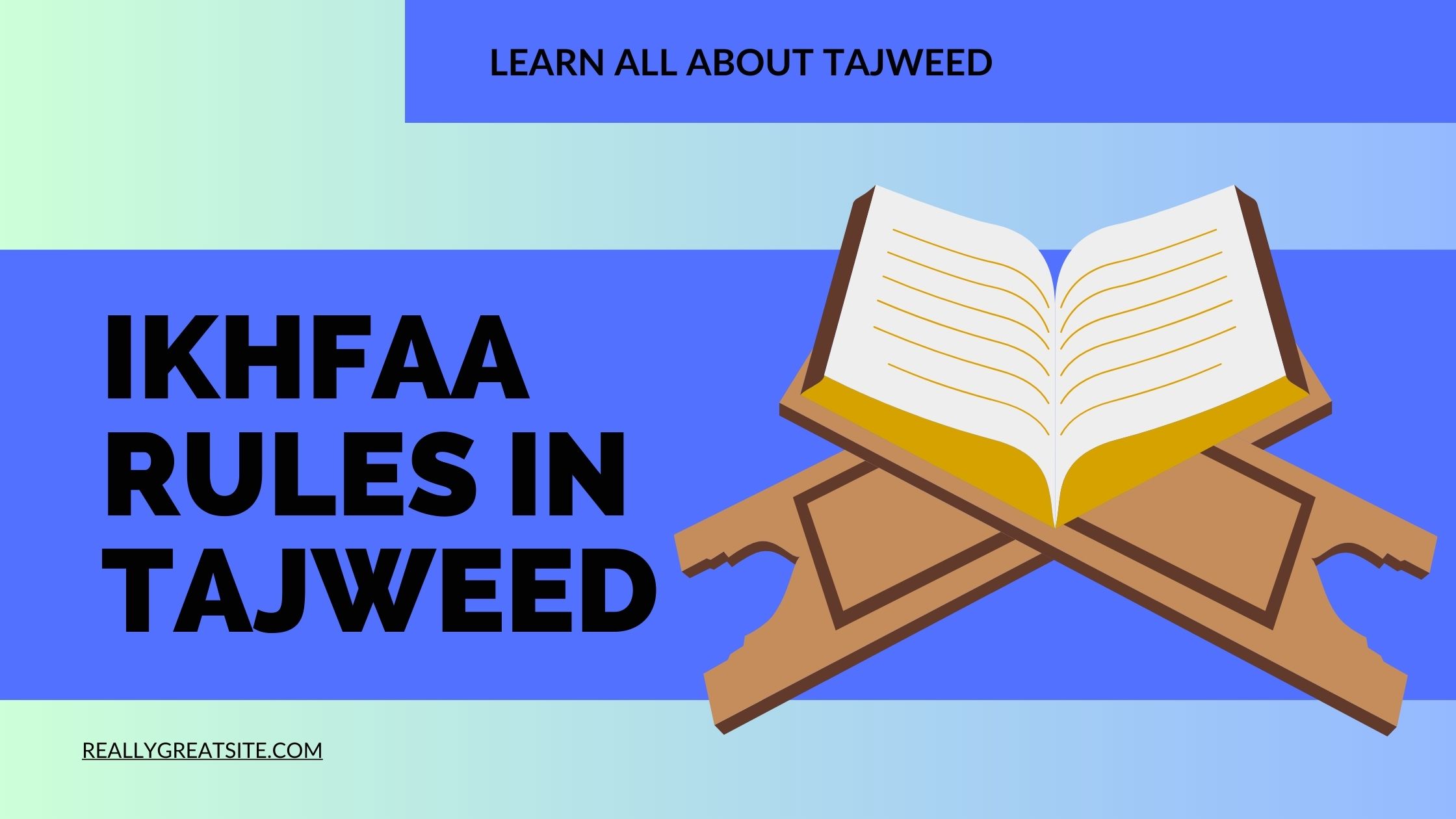Learn all about the rules of Ikhfaa in Tajweed and how to practice them. You will learn what is Ikhfaa; What are Ikhfaa letters? Al-Ikhfaa’s Letters with Examples and More.
“Ikhfaa” in Tajweed refers to concealing the sound of a letter, particularly An-noon As-sakinah or the Tanween sign, while maintaining the nasal sound (ghunnah) and hiding the letter behind the following sound. There are fifteen Ikhfaa letters, such as ش، س، ز، ذ، د، ج، ث، ت، ك، ق، ف، ظ، ط، ض، ص, which trigger Ikhfaa when preceded by An-noon As-sakinah or At-tanween.
Mistakes in Ikhfaa often involve incorrect duration of ghunnah or confusion between Haqiqi and Shafawi Ikhfaa. Recognizing Ikhfaa in the Quran involves identifying An-noon As-sakinah or At-tanween followed by specific letters. Understanding Ikhfaa is essential for proper recitation of the Quran according to Tajweed rules.
Learn All in details below.
What is Ikhfaa?
The term Ikhfaa linguistically means to hide or cover a letter sound, in a way as if it is a silent letter. The Arabic word (Haqiqi) means real or obvious.
The meaning of the linguistic term of Ikhfaa in Tajweed knowledge means to pronounce the sound of the Arabic letter (An- noon As-saknhah) or the sign (Harkat) Tanween in a way that is between Izhaar and idghaam, retaining the ghunnah sound clear out of the nose (a nasal sound) while concealing the sound of the letter (An-noon) behind the sound that comes after it.
In simple words: Ikhfaa is to hide the whole of a letter sound or some of it while you are pronouncing it. In other words, Ikhfaa is a path between Izzhar and Idghaam.
Note: Terms to Understand Before Completing: We have to know some Tajweed phonetics expressions and idioms in order to understand what is meant by Ikhfa, here are these idioms:
| Ghonnah: | Ghonnah is a nasal sound thatis produced when you utter the sound of the letter (N – ن) from your nose. In other words: It is to pronounce the sound of the Arabic letter (AL Noon) or (AL Meem), with a nasal sound from the nose for a period of approximately two seconds. |
| Izzhar: | Izhar is to make the sound of a certain letter completely clear and voiced. |
| Idghaam: | Idghaam is to mix or combine two sounds into one sound, the preceding sound with the sound that follows it. |
What are the Rules of Ikhfaa in Tajweed?
The Tajweed rule of Al-Ikhfaa is as follows: If any of the fifteen Arabic letters of Ikhfaa are preceded by An-noon As-sakinah or At-tanween, then, An-noon As-sakinah and At-tanween should be hidden when they are pronounced with making the sound of ghunnah for approximately two beats of seconds.
Note: You can Learn Quran and Taweed with Kalimah Center.
What are Ikhfaa letters (Haqiqi)?
The Arabic letters of Al-Ikhfaa Al-Haqiqi (that means to be the clear and obvious hidden pronunciation of letters) are fifteen Arabic letters of the Arabic language alphabet. If any letter of these fifteen letters comes after An-noon As-Sakinah or At-tanween, there will be Ikhfaa Haqiqy (clear).
Here are the fifteen Arabic letters of Al-Ikhfaa:
| ش | س | ز | ذ | د | ج | ث | ت |
| #### | ك | ق | ف | ظ | ط | ض | ص |
How To Remember Ikhfaa letters?
There are three kinds of tips that can always assist you in reminding the fifteen letters of Al-Ikhfa
Here they are:
1. The rest of the letters after Al-Izhaar, Idghaam, and Iqlab letters
In Direct Opposition to Al-Izhaar, Idghaam, and Iqlab letters
When you Know that the letters of Al-Izhaar are:
| خ | غ | ح | ع | ه | ء |
And the Arabic letters of Idghaam are:
| ن | و | ل | م | ر | ي |
And when you memorize that the letter of Iqlab ruling is (ب)
Then, the remaining letters of the Arabic alphabet are fifteen letters.These fifteen letters are Al-Ikhfaa’s letters.
2. Divide Ikhfaa Letters Into Groups:
Memorizing Al-Ikhfaa’s letters by dividing them into groups, using the fifteen pieces of the five figures of one hand, which form fifteen letters.
3. Memorize an Arabic Sentence:
The last tip is to memorize the following Arabic sentence, the letters of Al-Ikhfaa are at the beginning of each word of this Arab sentence.
Here the Arabic sentence is:
صِف ذا ثَنَا كَمْ جَادَ شَخْصٌ قَدْ سَمَا دُمْ طَيِّبًا زِدْ في تُقًي ضَعْ ظَالِمًا
Types of Ikhfaa: Ikhfaa’ Haqiqy (clear) and Ikhfaa’ shafawi Difference:
There are two types of Ikhfaa: Ikfaa Haqiqi and Ikhfaa Shafawi. The difference between Ikhfaa’ Haqiqy (clear) and Ikhfaa’ shafawi (oral) has to do with the way each one is pronounced.
1. Ikhfaa Haqiqi:
Al-Ikhfaa Al Haqiqi is to conceal the sound of An-noon As-sakinah or At-tanween if any letter of the fifteen letters comes after them.
2. Ikhfaa Shafawi:
Ikhfaa Shafawi is to conceal or hide the sound of the Arabic letter Al-Meem As-sakinah (م) withholding Al-ghunnah sound in case it is followed by the Arabic letter (ب).
Al-Ikhfaa Ash-shafawi is named so because the place of articulation (voice Makhrij) of the Arabic letter “Meem” and the Arabic letter “Baa” are the same. They are pronounced by the lips.
Here are some examples:
- تَرْمِيهِم بِحِجَارَةٍ
- وَهُم بِالْآخِرَةِ
How Can We Pronounce Al-Ikhfa Letters?
The correct pronunciation of the Ikhfaa rule is to articulate An-noon or Tanween sound by placing the front of your tongue in the upper part of your mouth with making Al Ghunnah Sound. But it is worth mentioning that You should avoid letting the tip of tongue touch the upper part of your mouth while you are articulating Ghunnah.
Ikhfaa’s ghunnah sound ruling is the same as the letter that comes after an-noon or At-tanween, regarding the heaviness or the lightness of the letter that comes after, which means that the Ikhfaa’s ghunnah sound is heavy if it is followed by a heavy letter and it is light if it is followed by a light letter.
How To Recognize The Ikhfaa Rule in the Mosihaf (The Arabic Version of the Holy Quran)?
We can easily identify Al-Ikhfaa while we are reading the Arabic version of the holy Quran by one of the following means:
- When we meet the Arabic letter An-Noon which is called (naked Noon) it means Noon without any of the phonetic signs (Kasrah, Dhammah, and Fatt-ha). That means there is nothing above it at all.
- When we find At-tanween above or under a letter (which means double of fatt-ha, double of kasrah, or double of Dhammah) and the letter that follows has no shaddah (an Arabic phonetic sign).
What is The Main Reason Behind the Sound of Al-Ikhfaa?
The reason that forces us to articulate the sound of Al-Ikhfaa is that the position of articulations (makharaj) of al-ikhfaa’s fifteen letters of the Arabic letter, Al-Noon, are neither the same as Al-Idghaam place of articulation nor Al-Izhaar place of articulation.
Thus, we are forced to pronounce them somehow between the way of Al-Idghaam articulation and Al-Izhaar articulation.
The Three Levels of Ikhfaa in Tajweed:
Al-Ikhfaa has three levels, it mainly depends on the positions of articulation of the Arabic letter “An-noon” or the Arabic phonetic sign “At–tanween“. So, there are three kinds or levels of Al-Ikhfaa rule. They are as follows:
1. The High Level of Al-Ikhfaa:
The high degree of ikhfaa occurs when An-noon As-sakinah or At-tanween Sign is followed by the Arabic letters (د ، ت ط).
In this case, Al-Ikhfaa turns to be- to some extent- similar to Al-Idghaam because the positions of articulations (Makharaj) of these three Arabic letters are adjacent to the position of articulation (makhraj) of the Arabic letter An-noon or the Arabic phonetic sign, At-tanween.
2. The low degree of Al-Ikhfaa:
The low degree of Al-Ikhfaa rule happens when An-noon As-sakinah or At-tanween Sign is followed by two Arabic letters which are (ق ، ك).
In this case, it is- to some extent- similar to the rule of Al-Izhaar because the places of articulation to these two Arabic letters are not close to the position of articulations of An-noon and At-tanween sign.
3. The In-Between Degree of Al-Ikhfaa:
This case happens when one of the other ten Arabic letters comes after An-noon or At-Tanween. That is because the positions of articulation are neither remote nor adjacent to the position of articulations of An-noon As-sakinah or At-tanween.
Common Mistakes Relating to Al-Ikhfaa Rule:
Here are some of the most common errors that some reciters often do when they Recite a verse of Quran containing ikhfaa:
1. Unsuffeciant Duration of Ikhfaa Ghunah:
Pronouncing the ghunnah sound with more or less duration. They should know that the appropriate duration of ghunnah sound is approximately two seconds. To avoid this error, they can use their fingers to count the proper time.
2. No Differentiation Between Haqiqi and Shafawi Ikhfaa:
Some Reciters have difficulty in differentiating between the heavy sound of Al-Ikhfaa (with a full mouth), and the light sound of Al-Ikhfaa (with an empty mouth). They should be aware of the Arabic letter that comes next.
3. Stressing the Ghunah:
They should not also put stress on the sound of ghunnah, because this makes it more similar to the sound of Al-Idgham.
Examples of the Ikhfaa Rule:
Test your proficiency! As you have read this article about the rules of Al-Ikhfaa, you can now test how good you are in this Tajweed rule.
Find where Al-Ikhfaa should be done in the following Qur’an verses
Verse Number 1:
“إِنْ تَسْتَفْتِحُوا فَقَدْ جَاءَكُمُ الْفَتْحُ ۖ وَإِنْ تَنْتَهُوا فَهُوَ خَيْرٌ لَكُمْ ۖ وَإِنْ تَعُودُوا نَعُدْ وَلَنْ تُغْنِيَ عَنْكُمْ فِئَتُكُمْ شَيْئًا وَلَوْ كَثُرَتْ وَأَنَّ اللَّهَ مَعَ الْمُؤْمِنِينَ”
Surah Al-Anfal verse, Number 19.
“If you desire a verdict, the verdict has come to you. And if you desist, it would be best for you. And if you return, we will return; and your troops, however numerous, will not benefit you. God is with the believers.”
Verse Number 2:
” وَبَشِّرِ الَّذِين آمَنُواْ وَعَمِلُواْ الصَّالِحَاتِ أَنَّ لَهُمْ جَنَّاتٍ تَجْرِي مِن تَحْتِهَا الأَنْهَارُ كُلَّمَا رُزِقُواْ مِنْهَا مِن ثَمَرَةٍ رِّزْقًا قَالُواْ هَذَا الَّذِي رُزِقْنَا مِن قَبْلُ وَأُتُواْ بِهِ مُتَشَابِهًا وَلَهُمْ فِيهَا أَزْوَاجٌ مُّطَهَّرَةٌ وَهُمْ فِيهَا خَالِدُون”َ (سورة البقرة.)
Surah AL-Baqarah. Verse, Number 25
“Give good news ˹O Prophet to those who believe and do good that they will have Gardens under which rivers flow. Whenever provided with fruit, they will say, “This is what we were given before,” for they will be served fruit that looks similar but tastes different. They will have pure spouses;1 and they will be there forever.”
🌟 Unlock Your Potential in Arabic and Quran with Kalimah Center! 🌟
Ready to deepen your connection with the Quran and enhance your understanding of Arabic? Join Kalimah Center today and embark on a transformative journey of learning and growth! Our professional, handpicked Online Arabic and Quran Tutors are dedicated to helping you master these essential skills with ease and expertise.
📚 Explore Our Courses:
Online Arabic Course: Tailored to your level, our comprehensive Arabic program includes 16 teaching levels and 400+ hours of personalized sessions.
Online Quran With Tajweed Course: Perfect for non-Arabic speakers, our course spans 13 levels and equips you with Tajweed mastery from beginner to advanced.
Online Arabic Course For Kids: Nurture your child’s love for Arabic with our engaging and structured program, available in 24 levels for primary, intermediate, and secondary stages.
💡 Why Choose Kalimah?
Expert Tutors: Learn from native Arabic speakers and Ijazah-certified teachers who prioritize your progress.
Flexible Learning: Enjoy one-on-one classes, 24/7 access to materials, and interactive exercises for a dynamic learning experience.
Comfortable Environment: Benefit from a supportive and encouraging atmosphere, where mistakes are seen as opportunities for growth.
Proven Success: With over 8,000 students worldwide and glowing testimonials, Kalimah Center is your trusted partner in Arabic and Quran education.
🚀 Start Your Free Trial Today! 🚀
Don’t miss out on this life-changing opportunity to deepen your faith and knowledge. Sign up now for your free trial and take the first step towards becoming a better practicing Muslim with Kalimah Center!
Conclusion:
The term “Ikhfaa” in Tajweed refers to the act of hiding or covering the sound of a letter, specifically An-noon As-sakinah or the Tanween sign, while maintaining the nasal sound (ghunnah) and concealing the sound of the letter behind the following sound. Ikhfaa serves as a middle ground between Izhaar and Idghaam. There are fifteen letters known as Ikhfaa letters, and when preceded by An-noon As-sakinah or At-tanween, Ikhfaa should be applied.
These letters include ش، س، ز، ذ، د، ج، ث، ت، ك، ق، ف، ظ، ط، ض، ص. Ikhfaa can be remembered by dividing the letters into groups, using mnemonic sentences, or recognizing their positions in relation to other Tajweed rules. There are two types of Ikhfaa: Haqiqi (clear) and Shafawi (oral), distinguished by their pronunciation.
Mistakes in Ikhfaa often involve incorrect duration of ghunnah, confusion between Haqiqi and Shafawi Ikhfaa, and stressing the ghunnah sound. Recognizing Ikhfaa in the Quran involves identifying An-noon As-sakinah or At-tanween followed by certain letters. Understanding Ikhfaa is crucial for proper recitation of the Quran according to Tajweed rules.














